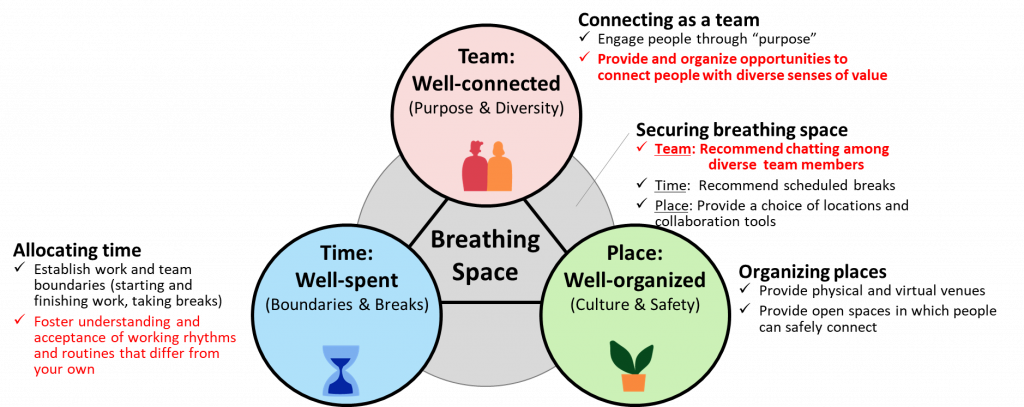In some companies and occupations, the hybrid work approach has firmly taken hold, resulting in many people likely experiencing changes in the way they engage with their colleagues. Rather than regularly seeing everyone at the office, as was the norm before, communication is conducted remotely. Amid this new work environment, onboarding—the process of integrating new employees into an organization—must be handled differently from the way it was in the past.
In this column, we will present the challenges of onboarding in a hybrid work environment and introduce examples of how the Rakuten Group carries out its onboarding initiatives.
Onboarding issues emerge
Recruit Management Solutions Co., Ltd. conducted a survey on onboarding with new graduates who joined the company in April 2019, when face-to-face training was the norm, and with new graduates who joined the company the following year, in April 2020, when training was increasingly held remotely.*1
One of the survey questions, for which multiple responses were allowed, was: “Looking back on your first year in the company, what did you find helpful, or what would you have preferred more of, in performing your job well and getting used to the organization and workplace?” Comparing the responses of the two target groups revealed differences in two items related to internal communication: “interactions with peers” and “interactions with workplace members outside of work.”
For both of these items, a higher percentage of the employees who joined in 2019 said they found such interactions helpful, while a higher percentage of those who joined in 2020 said they wished they had been able to have more of it.
Based on these findings, it appears that onboarding in a hybrid work environment creates issues in the form of reduced opportunities for interactions with colleagues in the company. These two items in particular suggest a loss of opportunities to share organizational context and get to know each other better in a relatively casual setting.
Organizational socialization: What is the rite of passage for new members joining an organization?
When new employees become members of an organization and adapt to that organization, they go through a process called “organizational socialization.”
Organizational socialization refers to the process by which an individual entering an organization accepts the organization’s norms, values, and behaviors, acquires the skills necessary to perform the duties of the job, and adapts to the organization in order to become a member. (Takahashi, 1993, p.2)
Ogata (2008) categorized the learning content in organizational socialization as follows.

People who newly join an organization are expected to learn such things during the onboarding process. Back when everyone worked in the office, such information was likely made available not only through such formal channels as newcomer training, but also through such relatively informal channels as “interactions with peers” or “interactions with workplace members outside of work,” as highlighted in the Recruit Management Solutions Co., Ltd. survey results mentioned earlier, or even chats that took place in the office.
Accordingly, in the current office environment amid increased online communication, the new challenge for organizations is how to achieve the same quantity and quality of human connections and information that were previously made possible through face-to-face encounters.
Rakuten Group initiatives (1): 50 1-on-1s to ensure the quantity and quality of connections
In August 2020, when employees were mostly working remotely, a division within the Rakuten Group began addressing these challenges.
According to the results of an independent survey of employees in the division, working within a hybrid work environment led to challenges in “a sense of unity with colleagues,” “communication across hierarchies,” and “access to information.” Based on these results, two initiatives were launched, one of which we will introduce in this column.
The first initiative, 1-on-1 meetings, is designed to help new members communicate more smoothly, both vertically within the organization’s hierarchy and horizontally across its team groupings, soon after joining the company. These meetings are designed to improve the quantity and quality of communication between newly hired or transferred employees in their first three months and existing employees. But these aren’t simply 1-on-1 meetings with a select handful of people. The target that was set for all new arrivals to one of the company’s organizations stipulated that they must have meetings with 50 existing employees. This approach aimed to address the quantitative aspect of information during the start-up period.
Because of the need to get to know the others well within their team, they basically hold 1-on-1 meetings with all the members in their new division. Another unique aspect of this policy is that meeting-partner candidates from other divisions are sometimes recommended by someone other than the new arrival’s immediate manager. And it’s not unusual for the people from the other divisions to introduce the next person with whom to meet.
In such cases, based on the content of the conversation during the meeting, the next person to be introduced is often someone the new arrival will likely need to know, or someone who they would find interesting to have a conversation with. Therefore, not only does this approach naturally lead to meeting one beneficial person after another through “invisible divine guidance,” but it also makes possible connections with unexpected individuals that the new arrival’s manager never could have imagined. This, in turn, contributes to improving the quality of relationships with others.
In addition, this qualitative effect of building an appropriate and unpredictable network could, in large part, be attributed to the quantitative support provided through the holding of 1-on-1s with as many as 50 people.
In light of the organizational socialization learning content in Ogata (2008), presented earlier, this “50-person 1-on-1” approach provides new members with the opportunity to learn: the “2. Names, positions, hobbies, personalities, and backgrounds of workplace colleagues” and, based on the connections that are introduced, makes it possible to gain an understanding for the “3. Relationships within the workplace and organization.” Also, through conversations with as many as 50 people, it’s fair to say that the new arrivals are able to visualize the “8. Roles of the organization or division” and their “9. Own role within the organization and workplace.”
Furthermore, depending on the content of the conversations, new members are also likely to cover other items within the learning content.

Connections to collective well-being
How does the 50-person 1-on-1 initiative connect with the three key elements of collective well-being—Team, Time and Place + Breathing Space—as advocated by our People & Culture Lab?

Looking at Figure 2, we can see that these 50 1-on-1 meetings closely link to “Providing and organizing opportunities to connect people with diverse senses of value” (Team) and “Team: Recommending chatting among diverse team members” (Breathing space). Based on the nature and objectives of this initiative, it appears clear that, among the three key elements, the connection to “Team” is the strongest.
Additionally, for example, by realizing during a casual conversation that your life stage differs from that of the person you are chatting with, you could gain a deeper “understanding of working rhythms and routines that differ from your own” (Time).
In the next installment, we will introduce tools that can be effectively used in online meetings during the onboarding process. We will see how the combination of the two initiatives presented in this and the next column are able to cover the three key elements.
New members to an organization tend to have fewer acquaintances and less information in that organization than those who are already working there, which can be the source of anxiety during the start-up process. In a hybrid work environment, a lack of interaction with colleagues may add to that anxiety, and reduced interaction may slow down learning during the organizational socialization process.
One undeniable feature of the videoconferencing systems that have proliferated in the world of remote work is that, for better or worse, they have made it relatively easy to make appointments efficiently. They have made this possible by doing away with the need to travel while enabling meetings to be conducted from anywhere.
We believe that this 50-person 1-on-1 approach effectively capitalizes on the current hybrid work environment, enabling newcomers to an organization to connect with a large number of existing members in a short period of time and in a powerfully meaningful way.
You may also want to consider employing such an approach in your organization to help new arrivals better handle the organizational socialization process and boost their well-being.
*1 Recruit Management Solutions “New-hire survey: Onboarding in the first year of employment, before and after the introduction of remote work” (in Japanese) (Referenced on March 1, 2023).
Works cited:
Ogata, M. (2008). A Comprehensive Consideration of Organizational Socialization Process in Young Workers. Konan Business Review, 48 (4), 11-68.
Takahashi, K. (1993). Research on Organizational Socialization, Japanese Journal of Administrative Science, 8 (1), 1-22.

